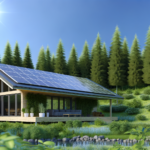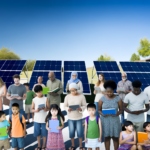Introduction to Solar Power for Adventurers
Why Solar Power?
For adventurers who thrive on exploring the great outdoors, the need for a reliable and sustainable power source is paramount. Solar power offers an ideal solution, harnessing the energy of the sun to provide electricity in remote locations where traditional power sources are unavailable. Unlike fossil fuels, solar energy is renewable and environmentally friendly, making it a perfect match for those who wish to minimize their ecological footprint while enjoying nature.
Benefits of Solar Power for Outdoor Enthusiasts
Solar power brings a multitude of benefits to outdoor enthusiasts, including:
- Independence from the Grid: Solar power allows adventurers to venture off the beaten path without worrying about access to electrical hookups or fuel supplies.
- Cost Savings: After the initial investment in solar equipment, the ongoing cost of generating power is minimal, as sunlight is free.
- Quiet Operation: Unlike noisy generators, solar panels operate silently, preserving the tranquility of the natural environment.
- Low Maintenance: Solar power systems require minimal upkeep, making them a hassle-free option for long-term use.
- Environmental Impact: Using solar energy reduces reliance on fossil fuels, decreasing greenhouse gas emissions and promoting sustainable living.
Overview of Solar Technology
Understanding the basics of solar technology is essential for making informed decisions about solar power systems. Here are the key components and concepts:
- Solar Panels: These devices convert sunlight into electricity using photovoltaic (PV) cells. The most common types of solar panels are monocrystalline, polycrystalline, and thin-film, each with its own efficiency and cost characteristics.
- Charge Controllers: These devices regulate the voltage and current coming from the solar panels to the batteries, preventing overcharging and ensuring efficient energy storage.
- Batteries: Solar power systems often include batteries to store energy for use when sunlight is not available, such as during nighttime or cloudy days.
- Inverters: Inverters convert the direct current (DC) electricity generated by solar panels into alternating current (AC) electricity, which is used by most household appliances and electronic devices.
- Mounting Systems: These structures secure solar panels in place, either on the ground or on rooftops, and are designed to optimize the angle and exposure to sunlight.
By integrating these components, a solar power system can efficiently capture, store, and utilize solar energy, providing a reliable power source for adventurers in even the most remote locations. Whether you’re planning a weekend camping trip or a long-term off-grid adventure, understanding and leveraging solar technology can significantly enhance your outdoor experience.
Understanding Solar Power Basics
How Solar Panels Work
Solar panels, also known as photovoltaic (PV) panels, convert sunlight into electricity. This process begins when sunlight hits the solar cells within the panel, which are typically made of silicon. The sunlight excites electrons in the silicon cells, creating an electric current. This current is then captured by wiring within the panel and directed to an inverter, which converts the direct current (DC) electricity into alternating current (AC) electricity that can be used to power devices and appliances.
Types of Solar Panels
There are several types of solar panels available, each with its own advantages and disadvantages:
- Monocrystalline Solar Panels: These panels are made from a single, continuous crystal structure. They are known for their high efficiency and long lifespan but tend to be more expensive.
- Polycrystalline Solar Panels: Made from multiple silicon crystals, these panels are less efficient than monocrystalline panels but are more affordable. They are a popular choice for budget-conscious adventurers.
- Thin-Film Solar Panels: These panels are made by depositing a thin layer of photovoltaic material onto a substrate. They are lightweight and flexible, making them ideal for portable applications, but they generally have lower efficiency compared to crystalline panels.
Key Components of a Solar Power System
A complete solar power system consists of several key components that work together to generate, store, and distribute electricity:
- Solar Panels: The primary component that captures sunlight and converts it into electricity.
- Inverter: Converts the DC electricity generated by the solar panels into AC electricity, which is used by most household appliances and devices.
- Battery Bank: Stores excess electricity generated by the solar panels for use when sunlight is not available, such as during nighttime or cloudy days.
- Charge Controller: Regulates the flow of electricity from the solar panels to the battery bank, preventing overcharging and potential damage to the batteries.
- Mounting System: Secures the solar panels in place, either on a roof, ground, or portable setup, ensuring they are positioned to capture the maximum amount of sunlight.
- Wiring and Connectors: Essential for connecting all the components of the solar power system, ensuring the safe and efficient transfer of electricity.
Understanding these basics will help you make informed decisions when selecting and setting up a solar power system for your outdoor adventures.
Choosing the Right Solar Equipment
Portable Solar Panels
Portable solar panels are an excellent choice for adventurers who need a flexible and mobile power solution. These panels are designed to be lightweight and easy to transport, making them ideal for camping, hiking, and other outdoor activities. Portable solar panels typically come in foldable or rollable designs, allowing you to set them up quickly and pack them away just as easily. They can be used to charge small devices like smartphones, GPS units, and portable lights, or even to power small appliances when combined with a suitable battery pack.
Solar Chargers and Power Banks
Solar chargers and power banks are essential for adventurers who need to keep their electronic devices charged while on the go. Solar chargers are small, portable panels that can be used to directly charge devices via USB ports. They are perfect for charging smartphones, tablets, and other small electronics. Power banks, on the other hand, store energy generated by solar panels and can be used to charge devices later. Some power banks come with built-in solar panels, while others need to be connected to an external solar panel. When choosing a solar charger or power bank, consider the capacity (measured in mAh) and the number of devices you need to charge.
Solar Generators
For those who need more substantial power solutions, solar generators are a great option. These devices combine solar panels with a battery storage system and an inverter, allowing you to power larger appliances and electronic devices. Solar generators are ideal for extended camping trips, RVs, and off-grid living. They can power everything from laptops and refrigerators to medical devices and power tools. When selecting a solar generator, consider the wattage output, battery capacity, and the types of outlets available (AC, DC, USB).
Factors to Consider When Choosing Equipment
Choosing the right solar equipment involves several key considerations:
- Power Needs: Determine the total wattage and type of devices you need to power. This will help you choose the appropriate size and type of solar panel, charger, or generator.
- Portability: If you need to move frequently or carry your equipment over long distances, opt for lightweight and compact options.
- Durability: Look for equipment that is rugged and weather-resistant, especially if you plan to use it in harsh outdoor conditions.
- Efficiency: Higher efficiency panels and chargers will generate more power in less time, which is crucial when sunlight is limited.
- Compatibility: Ensure that the solar equipment you choose is compatible with your devices and any existing power systems you have.
- Budget: Balance your needs with your budget. While higher-end equipment may offer better performance and durability, there are also cost-effective options that can meet basic needs.
By carefully considering these factors, you can select the right solar equipment to enhance your outdoor adventures, ensuring you have reliable power wherever you go.
Setting Up Your Solar Power System
Planning Your Setup
Before diving into the installation of your solar power system, it’s crucial to plan your setup meticulously. Start by assessing your energy needs. Calculate the total wattage of all the devices and appliances you intend to power using solar energy. This includes everything from lights and mobile devices to larger appliances like refrigerators and air conditioners.
Next, determine the number of solar panels required to meet your energy demands. A general rule of thumb is that a 100-watt solar panel produces approximately 350 watt-hours per day under optimal conditions. However, factors such as weather, shading, and panel efficiency can affect this output.
Consider the available space on your RV or camper’s roof for mounting the panels. Ensure that the panels will receive maximum sunlight exposure throughout the day. Additionally, decide whether you want a portable or permanent solar panel system. Portable systems offer flexibility and ease of setup, while permanent systems provide continuous power generation and are more efficient in the long run.
Installation Tips and Tricks
Once you have a solid plan, it’s time to install your solar power system. Here are some tips and tricks to ensure a smooth installation process:
1. **Mounting the Panels**: Securely mount the solar panels on the roof of your RV or camper. Use appropriate mounting brackets and ensure the panels are angled to capture maximum sunlight. If using portable panels, place them in an area with the most sun exposure.
2. **Wiring**: Run the wiring from the solar panels to the charge controller inside your RV. Use weatherproof connectors and ensure the wires are properly insulated. You can route the wires through existing vents or drill a hole in the roof, sealing it thoroughly to prevent leaks.
3. **Charge Controller**: Install the charge controller close to the battery bank. The charge controller regulates the voltage and current from the solar panels to prevent overcharging and damage to the batteries. Connect the wires from the solar panels to the charge controller and from the charge controller to the battery bank.
4. **Inverter**: If you plan to use AC appliances, install an inverter near the battery bank. The inverter converts DC power from the batteries to AC power. Ensure the inverter’s capacity matches your power needs and connect it to the battery bank.
5. **Testing**: Before finalizing the installation, double-check all connections and ensure the polarity is correct. Test the system by covering the solar panels and then uncovering them to see if the charge controller and inverter are functioning correctly.
Safety Considerations
Safety should be a top priority when setting up your solar power system. Here are some key safety considerations:
1. **Electrical Safety**: Always disconnect the battery before working on the electrical system to avoid shocks. Use appropriate fuses and circuit breakers to protect the system from overcurrent.
2. **Proper Ventilation**: Ensure the battery bank is well-ventilated to prevent overheating. Avoid placing batteries in enclosed spaces without adequate airflow.
3. **Secure Mounting**: Ensure all components, including solar panels, charge controllers, and inverters, are securely mounted to prevent movement during travel.
4. **Weatherproofing**: Use weatherproof connectors and seal any drilled holes to prevent water ingress. Regularly inspect the system for any signs of wear or damage.
5. **Professional Help**: If you’re unsure about any aspect of the installation, seek professional help. Incorrect installation can lead to system failure or even pose a fire hazard.
By carefully planning your setup, following installation best practices, and prioritizing safety, you can successfully set up a reliable and efficient solar power system for your outdoor adventures.
Maintaining and Troubleshooting Your Solar Power System
Routine Maintenance
Regular maintenance is crucial to ensure the longevity and efficiency of your solar power system. Here are some key tasks to include in your routine:
- Cleaning Solar Panels: Dust, dirt, and debris can accumulate on solar panels, reducing their efficiency. Clean the panels with a soft brush or a damp cloth to remove any buildup.
- Inspecting Connections: Regularly check all electrical connections, including those between the solar panels, charge controller, and battery. Look for signs of corrosion or loose connections and address them promptly.
- Monitoring Performance: Use a monitoring system to keep track of your solar power output. This can help you identify any drops in performance that may indicate a problem.
- Checking Batteries: If your system includes batteries, inspect them for any signs of wear or damage. Ensure they are properly charged and maintained according to the manufacturer’s guidelines.
Common Issues and Solutions
Even with regular maintenance, issues can arise. Here are some common problems and their solutions:
- Reduced Power Output: If you notice a drop in power output, check for shading on the panels, dirty panels, or faulty connections. Clean the panels and ensure there are no obstructions. Inspect and tighten any loose connections.
- Battery Not Charging: If your battery isn’t charging, check the charge controller settings and connections. Ensure the solar panels are producing enough power and that the charge controller is functioning correctly.
- Overheating Components: Overheating can damage your system. Ensure proper ventilation around all components and avoid placing them in direct sunlight. If overheating persists, consult the manufacturer for further guidance.
- Inverter Issues: If your inverter isn’t working, check for any error codes and refer to the user manual for troubleshooting steps. Ensure all connections are secure and that the inverter is receiving adequate power.
Extending the Lifespan of Your Equipment
To maximize the lifespan of your solar power system, consider the following tips:
- Quality Components: Invest in high-quality components from reputable manufacturers. While they may be more expensive upfront, they often offer better performance and durability.
- Proper Installation: Ensure your system is installed correctly, following all manufacturer guidelines. Improper installation can lead to premature wear and tear.
- Environmental Protection: Protect your equipment from extreme weather conditions. Use weatherproof enclosures for sensitive components and ensure proper drainage around the installation site.
- Regular Upgrades: Stay informed about advancements in solar technology. Upgrading components like inverters or batteries can improve efficiency and extend the overall lifespan of your system.
By following these maintenance and troubleshooting tips, you can ensure that your solar power system remains efficient and reliable, providing you with clean energy for all your outdoor adventures.
Maximizing Efficiency and Performance
Optimizing Solar Panel Placement
Proper placement of solar panels is crucial for maximizing their efficiency. Here are some key considerations:
- Orientation: In the Northern Hemisphere, panels should generally face south to capture the most sunlight. Conversely, in the Southern Hemisphere, they should face north.
- Tilt Angle: The tilt angle should be adjusted according to your geographical latitude. This ensures that the panels receive the maximum amount of sunlight throughout the year.
- Avoiding Shade: Even a small amount of shade can significantly reduce a panel’s efficiency. Ensure that trees, buildings, or other obstructions do not cast shadows on the panels, especially during peak sunlight hours.
- Spacing: Leave adequate space between panels to prevent overheating and to allow for proper airflow, which can enhance performance.
Energy Storage Solutions
Efficient energy storage is essential for making the most out of your solar power system. Here are some options:
- Solar Batteries: These are designed to store excess energy generated during the day for use at night or during cloudy periods. Lithium-ion batteries are popular due to their high efficiency and long lifespan.
- Portable Power Stations: Ideal for adventurers, these compact units can store energy and power various devices. They are perfect for camping trips or off-grid adventures.
- Hybrid Inverters: These devices combine the functions of a solar inverter and a battery inverter, allowing for seamless energy storage and usage.
Monitoring and Managing Energy Usage
Effective monitoring and management of energy usage can significantly enhance the performance of your solar power system. Consider the following strategies:
- Energy Monitoring Systems: These systems provide real-time data on energy production and consumption. They help identify inefficiencies and optimize energy usage.
- Smart Home Integration: Integrating your solar power system with smart home devices can automate energy usage, ensuring that appliances run during peak solar production times.
- Regular Audits: Conduct regular energy audits to identify areas where energy is being wasted. This can help in making necessary adjustments to improve overall efficiency.
By focusing on optimal panel placement, efficient energy storage solutions, and effective energy monitoring and management, you can maximize the efficiency and performance of your solar power system. This not only ensures a reliable source of clean energy but also contributes to long-term cost savings and a reduced environmental footprint.
Future Trends in Solar Technology
Innovations in Solar Panels
The solar panel industry is continuously evolving, with new innovations aimed at increasing efficiency and reducing costs. One of the most exciting developments is the advent of *bifacial solar panels*, which can capture sunlight from both sides, significantly boosting energy output. Additionally, *perovskite solar cells* are gaining attention for their potential to surpass traditional silicon-based panels in efficiency and flexibility. These cells are not only cheaper to produce but also easier to integrate into various surfaces, including windows and building facades.
Another promising innovation is the development of *transparent solar panels*. These panels can be used in windows and other transparent surfaces, allowing buildings to generate their own electricity without compromising aesthetics. This technology is particularly appealing for urban environments where space is limited.
Advancements in Energy Storage
Energy storage is a critical component of solar power systems, especially for adventurers who need reliable power in remote locations. Recent advancements in battery technology are making solar energy more viable and efficient. *Solid-state batteries* are emerging as a game-changer, offering higher energy density, faster charging times, and improved safety compared to traditional lithium-ion batteries.
Moreover, *flow batteries* are gaining traction for their scalability and long cycle life. These batteries use liquid electrolytes to store energy, making them ideal for large-scale solar installations. For portable applications, *lithium-sulfur batteries* are being developed to provide higher energy density and lighter weight, which is crucial for adventurers who need to minimize their gear load.
The Role of Solar Power in Sustainable Living
Solar power is playing an increasingly vital role in promoting sustainable living. As the world grapples with climate change and environmental degradation, solar energy offers a clean, renewable alternative to fossil fuels. The integration of solar power into everyday life is becoming more seamless, with innovations like *solar-powered appliances* and *solar-integrated building materials*.
In addition to reducing carbon footprints, solar power is also enhancing energy independence. Communities and individuals can generate their own electricity, reducing reliance on centralized power grids and increasing resilience against power outages. This is particularly beneficial for adventurers who often find themselves in off-grid locations.
Furthermore, the concept of *solar sharing* is gaining popularity. This involves communities pooling resources to install solar panels and share the generated electricity, making solar power more accessible and affordable for everyone. This collaborative approach not only fosters a sense of community but also maximizes the utilization of solar resources.
In conclusion, the future of solar technology is bright, with continuous innovations and advancements making it more efficient, accessible, and integral to sustainable living. For adventurers, these developments mean more reliable and versatile solar power solutions, enabling them to explore the great outdoors with a reduced environmental impact.






